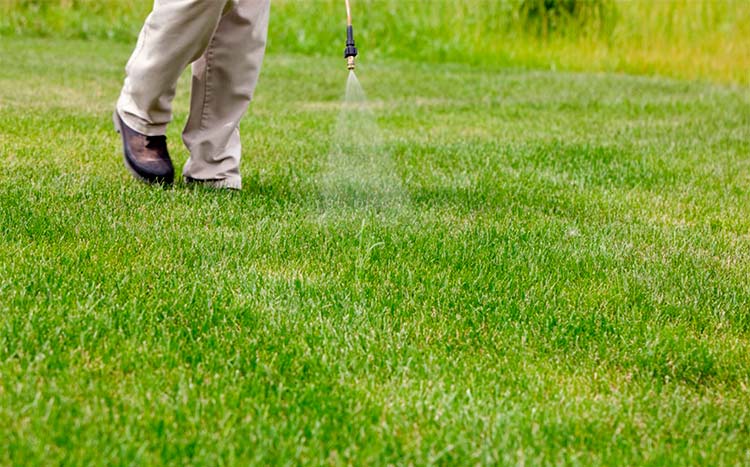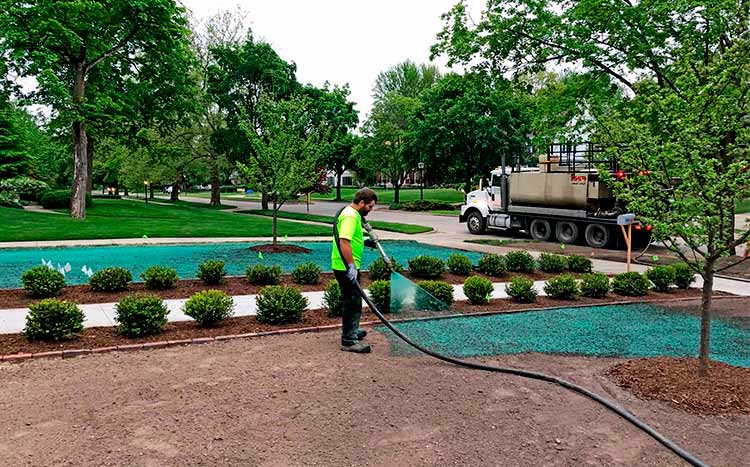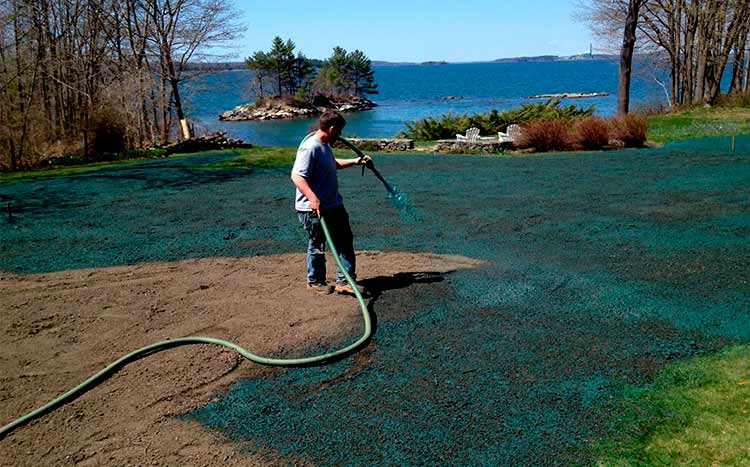Hydroseeding involves utilizing a mixture of grass seeds, mulch, fertilizer, and water to establish new lawns or restore existing ones. This technique allows homeowners to rejuvenate their thin or declining lawns, resulting in a thicker and healthier turf.
You can apply hydroseed over an existing lawn to fill patchy or bare sections without redoing the entire lawn. But you need to use a thinner slurry (mulch mixture) over the lawn to avoid suffocating the existing grass and killing your lawn.
You may also hydroseed public spaces and erosion-prone areas to protect the soil.
Can you hydroseed an existing lawn without adding topsoil
Adding topsoil to an existing lawn improves your lawn surface by leveling low and uneven areas where puddles form. Too much can smother the existing lawn so make sure blades of grass are peaking through when you do it.
I would reserve topsoil for patchy areas and leave the good grass alone.
The average lawn requires an additional topsoil layer with ¼ to ½ inch thickness for successful hydroseeding. However improper topdressing methods can:
- Can add enough strain to kill a section or the entire lawn grass.
- A thick layer of topsoil can smother and kill your existing lawn grass.
Gradually adding thin layers of topsoil to your lawn over several months is an excellent topdressing technique that will not kill the existing grass. And it also gives the grass enough time to adapt to the new soil.

How to topsoil a lawn before hydroseeding
The tips below can help you to topdress an existing lawn successfully.
- Do not use chemical fertilizers, pesticides, or herbicides on your lawn a couple of weeks before hydroseeding.
- Do not use better quality topsoil but with a heavier composition that is heavier than
- Inspect the topsoil for debris, stones, weed seeds, and insect larva, and ask about its source before buying and spreading it over your lawn.
- Allow the topsoil to dry before spreading it over your lawn in small chunks. A minimum of 75 percent of your lawn’s existing grass should be visible after spreading.
Can you seed over hydroseed?
You should not seed over hydroseed unless it is necessary. And no, it won’t kill the hydroseed. Although, several problems could occur if you do spread new seeds over sections of fresh hydroseed.
The problems include
- Overcrowding: the introduction of new seeds can cause intense competition for water and soil nutrients among too many grasses resulting in poor root development and encouraging the spread of lawn diseases.
- Poor seed-to-soil contact: broadcasting (spreading) new seeds over hydroseed mulch without raking them into the soil results in poor seed-to-soil contact, reducing the survival rate of the new seeds to about 15 percent.
- Increased pest activity: spreading new seeds on hydro-mulch attracts insects, birds, and rodents that feed on them.
Professionals suggest waiting till the hydroseed germinates before introducing new seeds to areas with patchy growth.

When is the best time to hydroseed?
The best time to hydroseed is during the fall and spring seasons because of the mild temperatures and low water consumption rate. However, summer is a more reasonable period for hydroseeding if you want faster germination because heat enhances seed growth than cold weather.
Benefits of hydroseeding an existing lawn.
Hydroseeding over an existing lawn is an edge give lawn maintenance technique with several benefits, which include:
- Homeowners use it to prevent lawn degradation.
- It is a fast method for restoring large lawns and landscapes.
- It is an excellent seeding method for revegetating large public spaces and restoring areas destroyed by forest fires with fast-growing grass species.
- Hydroseeding can provide uniform grass growth on lawns with uneven grass germination.
- It is a more cost-effective method than replanting patchy lawn areas with mature grass.
- It is an effective soil erosion control technique protecting vulnerable landscapes from wind and heavy rain.
- Hydroseeding existing lawns helps the ground retain larger amounts of soil moisture.
How does the hydroseeding mixture work?
The hydroseed mixture or slurry, as it is also known, is a special blend consisting of various ingredients that are sprayed over a lawn. The mixture usually contains the following:
- Grass seeds.
- Protective mulch to attach the seedlings to the soil, preventing rain from washing them away.
- Fertilizer to help seeds germinate.
- Water.
- Colorant to give it a distinctive green tone.
Hydroseeding starts when the slurry is mixed and poured into a container attached to a pump and hose. Once you activate the pump, it picks up the mixture and sprays it through the hose over an area.
Once the seeds are deposited on the lawn surface, the mulch coating acts as a layer of protection against diseases and binds the seedlings together and with the soil to prevent washouts. The fertilizer present in the mixture serves as early-stage nourishment aiding fast germination and growth.
Professional and DIY hydroseeding cost
By the time you hire the equipment, buy the hydroseed slurry and learn how to do it properly, you are probably best paying a professional to do the job right. You may just end up using more slurry than needed to make it more expensive in the long run.
Here is a breakdown of the price:
| Service | Quantity | Low | High |
|---|---|---|---|
| Hydroseeding cost per sq ft | 1 sq. ft. | $0.08 | $0.2 |
| Hydroseeding cost per hour | 1 hour | $55 | $125 |
| Hydroseeding cost per ¼ acre | ¼ acre | $750 | $2,000 |
| Average Hydroseeding cost | 7,500 - 20,000 sq.ft. | $425 | $3,500 |
Pros and cons of hydroseeding an existing lawn
There are certain things you must know about hydroseeding before utilizing the procedure. Hydroseeding has its pros and cons, which include:
Pros
- You can mix different seeds to grow a variety of grass species for your lawn.
- It covers a large area.
- It provides better disease resistance for your turf.
- It is a money-saving seeding option, with 50-80 percent cost savings.
Cons
- The results are not instant, unlike some seeding methods. And it usually takes about three months to see the full effects of hydroseeding.
- It requires considerable watering, which may be a problem in drought-stricken areas.
- Hydroseeding over an existing lawn requires significant topsoil addition.
- It is not cost-effective when used on smaller lawns.
Hydroseeding over existing grass
Hydroseeding over existing grass or a partial lawn is a common method of restoring residential and commercial landscapes. The procedure is a cost-effective means that gives homeowners the advantage of quickly rehabilitating a fading lawn without incurring extra expenses. However, professionals consider the process a high risk due to the possibility of killing lawn grass.
Hydroseeding over a neglected lawn.
Spraying a hydroseed mixture over a neglected lawn is an effective and quick rehabilitation method. It provides an opportunity to grow healthy grass without utilizing conventional seeding methods, which can be time-consuming. Some professionals prefer to aerate the lawn before hydroseeding for better results. Applying weed killers to remove unwanted vegetation before hydroseeding reduces competition for air, water, and soil nutrients helping grass seedlings germinate and develop deep roots.
Hydroseeding a patchy lawn.
You can hydroseed a lawn with patching or thinning areas by hydroseeding the lawn. Using hydroseed to fill patchy lawn sections can restore those areas without resorting to continuous tilling, grass seeding, watering, and fertilization. Homeowners can buy inexpensive DIY hydroseeding kits or hire a professional lawn service to perform the procedure.
FAQ's
Torrential rains can wash away a significant portion of the hydroseed. But using mulch and glue to secure your hydroseed to the soil gives the hydroseed better protection against washouts.
2-3 times of 10 to 20 minutes deep watering every day for the first three weeks will keep the mulch moist enough to hasten seed germination. Ensure the mulch is dry after hydroseeding before you commence the watering regimen.







